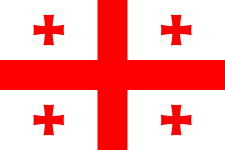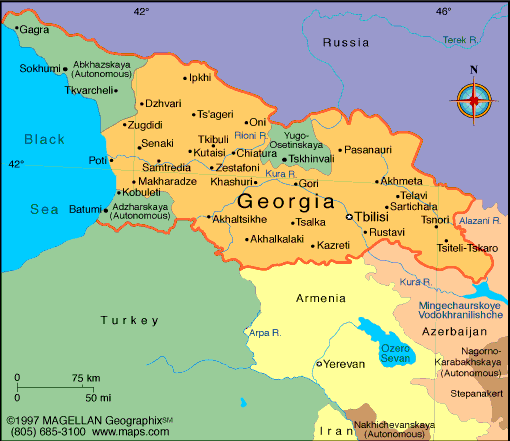GEORGIA

Geography: Georgia is bordered by the Black Sea in the west, by Turkey and Armenia in the south, by Azerbaijan in the east, and Russia in the north. The republic also includes the Abkhazia and Ajara autonomous republics and South Ossetia.
Government: Republic.
History: Georgia became a kingdom about 4 B.C. and Christianity was introduced in A.D. 337. During the reign of Queen Tamara (1184–1213), its territory included the whole of Transcaucasia. During the 13th century, Tamerlane and the Mongols decimated its population. From the 16th century on, the country was the scene of a struggle between Persia and Turkey. In the 18th century, it became a vassal to Russia in exchange for protection from the Turks and Persians.
Georgia joined Azerbaijan and Armenia in 1917 to establish the anti-Bolshevik Transcaucasian Federation, and upon its dissolution in 1918, Georgia proclaimed its independence. In 1922, Georgia, Armenia, and Azerbaijan were annexed by the USSR and formed the Transcaucasian Soviet Socialist Republic. In 1936, Georgia became a separate Soviet republic. Under Soviet rule, the country was transformed from an agrarian to a largely industrial, urban society.

Map of Georgia
President: Giorgi Margvelashvili (2013)
Prime
Minister: Irakli Garibashvili (2013)
Total area: 26,911 sq mi (69,700 sq
km)
Population (2014 est.): 4,935,880
(growth rate: –.11%); birth rate: 12.93/1000; infant mortality
rate: 16.68/1000; life expectancy: 75.72
Capital and largest city (2014 est.):
Tbilisi, 1.15 million
Other large cities: Kutaisi, 268,800; Batoumi, 145,400; and Sokhumi, 110,300
Monetary unit: Lari
National name:
Sak'art'velo
Languages:
Georgian 71% (official), Russian 9%, Armenian
7%, Azerbaijani 6%, other 7% (Abkhaz is the official language in
Abkhazia)
Ethnicity/race:
Georgian 83.8%, Azeri 6.5%, Armenian 5.7%,
Russian 1.5%, other 2.5% (2002)
Religions:
Orthodox Christian (official) 83.9%, Muslim 9.9%, Armenian-Gregorian 3.9%, Catholic 0.8%, other 0.8%, none 0.7% (2002 census)
Literacy rate:
99.7% (2012 est.)
Economic summary:
GDP/PPP (2014 est.): $34.27 billion; per capita $7,700. Real
growth rate: 5%. Inflation: 3.3%. Unemployment:
14.9% (2011 est.). Arable land: 5.76%. Agriculture:
citrus, grapes, tea, hazelnuts, vegetables; livestock. Labor force:
1.959 million (2011 est.); industry 8.9%, agriculture 55.6%, services
35.5% (2006 est.). Industries: steel, aircraft, machine tools,
electrical appliances, mining (manganese and copper), chemicals, wood
products, wine. Natural resources: forests, hydropower,
manganese deposits, iron ore, copper, minor coal and oil deposits;
coastal climate and soils allow for important tea and citrus growth.
Exports: $4.493 billion (2014 est.): scrap metal, machinery,
chemicals; fuel reexports; citrus fruits, tea, wine. Imports:
$8.328 billion (2014 est.): fuels, machinery and parts, transport
equipment, grain and other foods, pharmaceuticals. Major trading
partners: Turkey, Bulgaria, Russia, Armenia, UK,
Azerbaijan, Germany, Japan, Ukraine, China, U.S. (2013).
Communications: Telephones: main lines in
use: 1.276 million (2012); mobile cellular: 4.699 million (2012). Broadcast media:
1 public broadcaster in Tbilisi, 1 state-owned broadcaster in Ajaria
Autonomous Republic; 8 privately owned TV stations; state run public
broadcaster operates 2 TV stations; dozens of cable TV operators,
several major commercial TV stations, and several dozen private radio
stations; state run public broadcaster operates 2 radio stations (2012).
Internet hosts: 357,864 (2012). Internet users: 1.3 million
(2009).
Transportation: Railways:
total: 1,612 km (2008). Roadways: total: 19,109 km (2010). Ports and harbors:
Bat'umi, P'ot'i. Airports: 22 (2013).
International disputes:
Russia's military support and subsequent recognition of Abkhazia and
South Ossetia independence in 2008 continue to sour relations with
Georgia.
-------------------- o --------------------
No comments:
Post a Comment